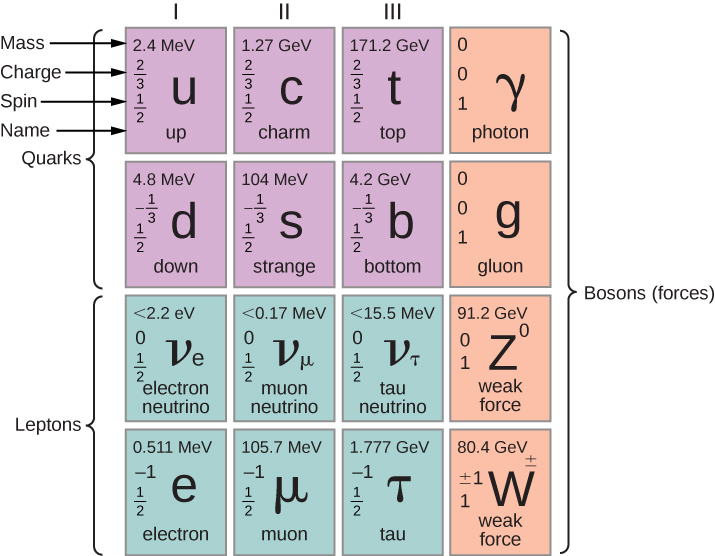| << Chapter < Page | Chapter >> Page > |

Ordinary matter consists of two types of quarks: the up quark (elementary charge, ) and the down quark Heavier quarks are unstable and quickly decay to lighter ones via the weak force. Quarks bind together in groups of twos and threes called hadron s via the strong force. Hadrons that consist of two quarks are called mesons , and those that consist of three quarks are called baryons . Examples of mesons include the pion and kaon, and examples of baryons include the familiar proton and neutron. A proton is two up quarks and a down quark and a neutron is one up quark and two down quarks ( , ). Properties of sample mesons and baryons are given in [link] . Quarks participate in all four fundamental forces: strong, weak, electromagnetic, and gravitational.
The lower two rows in the figure (in green) contain six leptons arranged into two particle families: electron, muon, and tau ( ), and electron neutrino, muon neutrino, and tau neutrino ( ). The muon is over 200 times heavier than an electron, but is otherwise similar to the electron. The tau is about 3500 times heavier than the electron, but is otherwise similar to the muon and electron. Once created, the muon and tau quickly decay to lighter particles via the weak force. Leptons do not participate in the strong force. Quarks and leptons will be discussed later in this chapter. Leptons participate in the weak, electromagnetic, and gravitational forces, but do not participate in the strong force.
Bosons (shown in red) are the force carriers of the fermions. In this model, leptons and quarks interact with each other by sending and receiving bosons. For example, Coulombic interaction occurs when two positively charged particles send and receive (exchange) photons. The photons are said to “carry” the force between charged particles. Likewise, attraction between two quarks in an atomic nucleus occurs when two quarks send and receive gluon s . Additional examples include W and Z boson s (which carry weak nuclear force) and gravitons (which carry gravitational force). The Higgs boson is a special particle: When it interacts with other particles, it endows them not with force but with mass. In other words, the Higgs boson helps to explains why particles have mass. These assertions are part of a tentative but very productive scientific model (the Standard Model) discussed later.
In the late 1920s, the special theory of relativity and quantum mechanics were combined into a relativistic quantum theory of the electron. A surprising result of this theory was the prediction of two energy states for each electron: One is associated with the electron, and the other is associated with another particle with the same mass of an electron but with a charge of . This particle is called the antielectron or positron . The positron was discovered experimentally in the 1930s.

Notification Switch
Would you like to follow the 'University physics volume 3' conversation and receive update notifications?